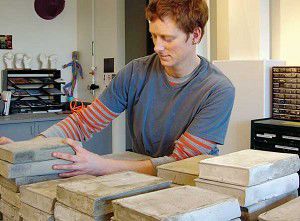Center features installation art
Published 10:30 am Thursday, January 22, 2009

- Artist Michelle Acuff stacks concrete books she cast as part of the installation for “A Topology of Thinking,” the 2009 exhibit season opening of the East Oregonian Gallery at the Pendleton Center for the Arts.<BR><I>Photo contributed by Michelle Acuff</i>
The 2009 opening exhibit in the East Oregonian Gallery might cause some visitors to question their preconceived notions about art. Rather than a collection of paintings or other art forms that can be considered individually, Whitman College professor Michelle Acuff will showcase installation art, which uses sculptural materials and other media to modify the way a particular space is experienced.
Trending
The artist’s work, titled “A Topology of Thinking,” will open with a reception from 5:30-7 p.m. Saturday in the main gallery located at the Pendleton Center for the Arts, 214 N. Main St.
Entry to the exhibit is free. It can be viewed from 10 a.m. to 4 p.m. Tuesday through Fridays and noon to 4 p.m. on Saturdays through Feb. 20.
Installation art came to prominence in the 1970s and changed the focus of sculpture from the object’s form to focus more on the viewer’s total sensory experience.
Trending
The gallery committee at the arts center invited Acuff to consider the beautiful East Oregonian Gallery, housed in the 1915 Carnegie Library building that once housed the community’s library. The building’s Italianate architecture struck a cord with Acuff, who spent time teaching in Italy two summers ago.
Her process began with a visit to the gallery and taking photographs, which she then studied for several months. Acuff was drawn to the big open room that was flooded with light. The classical style of the trim, fireplace and other details in the room were directly linked to the classical imagery she uses to introduce her university students to sculpture.
“The Italian sculptural icons were very present in my mind. I relate them to modes of perception,” Acuff said. “Also, the design of this space lends itself to certain expectations of how we’re supposed to look at art, and I wanted to challenge that.”
Acuff created a reproduction of Rodin’s iconic Thinker sculpture, which will be watching television – referring to the shift from text-based information to gathering information visually.
In her artist’s statement about the exhibit, Acuff writes that her current body of work, ” …mines the contemporary arena of cognitive science as a way to ask questions about the relationship between mind and matter, different kinds of intelligences, and the shifting cultural orientation from text to visually based language/knowledge. Using a trope of Western Sculptural history (The Thinker), I aim to explore the contemporary neuroscientific landscape where knowledge about the self is both imagined and constructed.”
Finally, Homer’s epic tale of “The Odyssey” forms part of the soundscape of this installation.
“It is curious that even the Greeks were deeply ambivalent and engaged in heated debates regarding whether or not a shift from an oral tradition to a written alphabet was desirable,” Acuff said.
Acuff , who is originally from the Midwest, received her bachelor’s degree in art from Augustana College and her master’s degree in fine arts, sculpture and intermedia from the University of Iowa.
She has been awarded several residencies and in 2006 received an Individual Artist Fellowship from the state of Mississippi.
The exhibit is made possible through the support of Cayuse Technologies, owned and operated by the Confederated Tribes of the Umatilla Indian Reservation.
Alanna Nanegos, business development manager for the company, was interested in the way Acuff uses technology as an art form and addressing themes of digital information.
“We appreciate the work they do at the arts center and thought this exhibit was a great fit for a partnership,” Nanegos said.
For more information, go to www.pendletonarts.org or call 278-9201.









